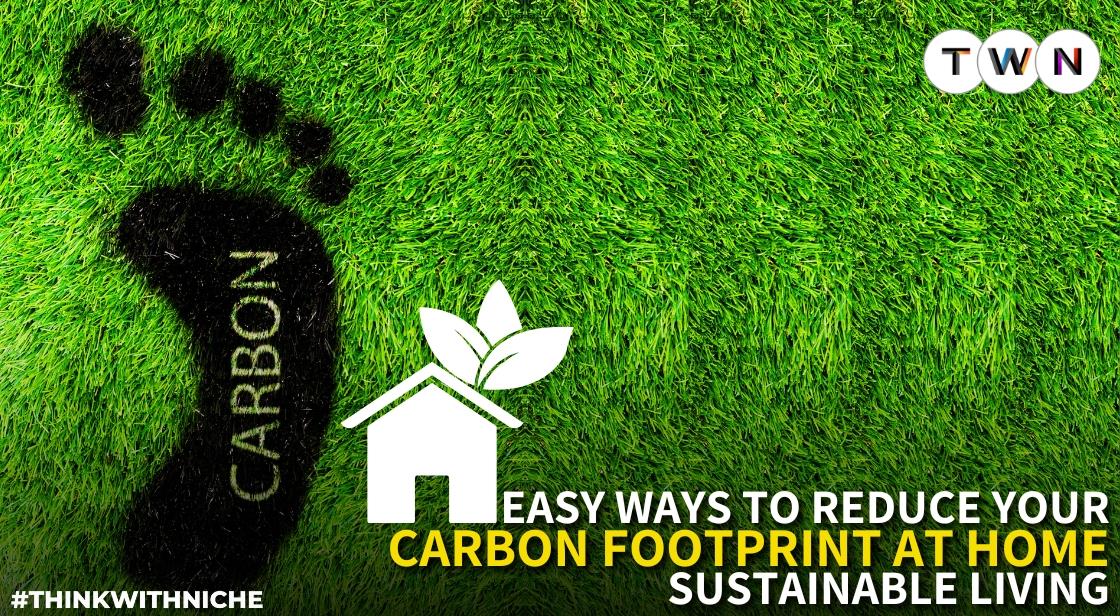Easy Ways to Reduce Your Carbon Footprint at Home: Sustainable Living

Blog Post
In an era where climate change and environmental sustainability are at the forefront of global concerns, individuals are increasingly seeking ways to reduce their carbon footprint and adopt more eco-friendly lifestyles. One significant avenue for making a positive impact on the environment is through sustainable living practices within the home.
From energy conservation to waste reduction, there are numerous simple yet effective strategies that homeowners can implement to minimize their environmental impact and contribute to a greener future.
At the heart of sustainable living is the recognition of the interconnectedness between human actions and the health of the planet. Every choice made within the home, from the products we purchase to the energy we consume, has the potential to either contribute to or mitigate climate change. With this understanding, individuals are empowered to make conscious decisions that align with their values of environmental stewardship.
This article aims to provide practical guidance on easy ways to reduce your carbon footprint at home, promoting sustainable living practices that are accessible to all. By focusing on simple adjustments in daily routines and household habits, readers can take meaningful steps towards living more sustainably without drastically altering their lifestyle. From energy-efficient upgrades to waste reduction strategies and eco-friendly shopping habits, each suggestion is designed to empower readers to make a positive environmental impact within the comfort of their own home.
By embracing sustainable living principles, individuals not only reduce their carbon footprint but also contribute to broader efforts to combat climate change and protect the planet for future generations. Through collective action and individual choices, we can create a more sustainable and resilient world for all.
Transforming Your Home into a Sustainable Haven
1. Energy-Efficient Practices:
Tips for reducing energy consumption and transitioning to renewable energy sources.
Transitioning to Renewable Energy:
-
Transitioning to renewable energy sources such as solar or wind power can significantly reduce reliance on fossil fuels.
-
Consider installing solar panels on your roof or investing in a community solar project.
Energy-Efficient Appliances:
-
Upgrading to energy-efficient appliances is crucial. Look for products with the ENERGY STAR label, indicating they meet strict energy efficiency guidelines set by the U.S. Environmental Protection Agency.
Smart Thermostat Installation:
-
Installing a programmable or smart thermostat can optimize heating and cooling systems, reducing energy waste.
-
These devices allow temperature adjustments based on your schedule.
Sealing Air Leaks:
-
Sealing gaps and cracks around windows, doors, and other areas where air can escape is important.
-
Proper insulation and weatherstripping improve energy efficiency and reduce heating and cooling costs.
LED Lighting:
-
Replace incandescent bulbs with energy-efficient LED bulbs.
-
LED bulbs use less energy and last longer, resulting in lower electricity bills and reduced environmental impact.
Unplugging Electronics:
-
Unplugging electronics when not in use prevents standby power consumption.
-
Using power strips or smart plugs can make it easier to turn off multiple devices at once.
Energy Audit:
-
Conducting a home energy audit helps identify areas for energy efficiency improvement.
-
Many utility companies offer free or discounted energy audits to provide insights into energy usage and savings opportunities.
2. Waste Reduction Strategies:
How to minimize waste generation through recycling, composting, and mindful consumption.
Recycling:
-
Implement a comprehensive recycling program at home.
-
Make sure recyclables are sorted correctly and familiarize yourself with the recycling regulations in your area.
Composting system:
-
Convert organic waste from landfills by starting a composting system.
-
Composting turns food scraps and yard waste into nutrient-rich soil for gardening.
Mindful Consumption:
-
Practice mindful consumption by avoiding single-use items and opting for reusable alternatives.
-
Select items with recyclable or little packaging to help reduce packaging waste.
Donate and Repurpose:
-
Donate unwanted items to charity organizations or host a garage sale to give them a new life.
-
Repurpose items creatively to extend their usefulness.
Minimalism:
-
Embrace minimalism by decluttering and prioritizing experiences over material possessions.
-
Simplifying your lifestyle can reduce waste and promote a more sustainable way of living.
Zero Waste Lifestyle:
-
Explore the principles of a zero waste lifestyle, aiming to minimize waste generation and maximize resource efficiency in daily activities.
Also Read: Sustainability Strategies for Businesses: Tips for Going Green
3. Eco-Friendly Transportation:
Exploring alternatives to traditional transportation methods, such as biking, walking, and carpooling.
-
Biking: Incorporate biking into your daily commute or errands whenever possible. Invest in a reliable bicycle and explore bike-friendly routes in your area.
-
Walking: Opt for walking for short-distance trips instead of driving. Walking not only reduces carbon emissions but also promotes physical health and well-being.
-
Carpooling: Share rides with friends, neighbors, or coworkers to reduce the number of vehicles on the road. One economical and green transportation choice is carpooling.
-
Public Transportation: Utilize public transportation systems such as buses, trains, or subways for longer commutes. Public transit reduces traffic congestion and lowers greenhouse gas emissions.
-
Electric Vehicles (EVs): Consider switching to an electric vehicle or hybrid car to reduce reliance on fossil fuels. EVs produce zero tailpipe emissions and have lower operational costs compared to traditional vehicles.
4. Green Home Upgrades:
Simple changes you can make to your home, such as installing energy-efficient appliances, LED lighting, and improving insulation.
-
Energy-Efficient Appliances: Upgrade to ENERGY STAR certified appliances to reduce energy consumption and lower utility bills.
-
LED Lighting: Replace incandescent bulbs with LED bulbs for energy-efficient lighting. LED bulbs last longer and use less energy, resulting in cost savings over time.
-
Improved Insulation: Enhance home insulation to prevent heat loss in winter and heat gain in summer. Energy efficiency is increased by proper insulation since it lessens the strain on heating and cooling systems.
-
High-Efficiency Windows: Install high-efficiency windows to improve insulation and reduce energy loss. Energy-efficient windows help maintain indoor comfort and reduce heating and cooling costs.
-
Smart Home Technology: Invest in smart home devices to optimize energy usage and improve home efficiency. Smart thermostats, lighting controls, and energy monitoring systems can help reduce energy waste.
-
Renewable Energy Systems: Consider installing renewable energy systems such as solar panels or wind turbines to generate clean electricity onsite. Renewable energy systems reduce reliance on fossil fuels and lower carbon emissions.
5. Water Conservation Techniques:
Ways to conserve water usage through efficient fixtures, rainwater harvesting, and landscaping practices.
-
Low-Flow Fixtures: To save water without compromising performance, install low-flow showerheads, toilets, and faucets. Low-flow fixtures conserve water and lower water bills.
-
Water-Efficient Appliances: Switch to water-saving equipment like washing machines and dishwashers. ENERGY STAR certified appliances use less water and energy, saving resources and money.
-
Rainwater Harvesting: Collect rainwater from rooftops and gutters for outdoor irrigation and landscaping. Rainwater harvesting reduces reliance on municipal water supplies and conserves freshwater resources.
-
Xeriscaping: Implement xeriscaping techniques to create water-efficient landscapes. Choose native plants, drought-tolerant species, and mulch to minimize water usage and maintenance requirements.
-
Greywater Recycling: Reuse greywater from sinks, showers, and laundry for non-potable purposes such as toilet flushing and outdoor irrigation. Greywater recycling reduces water waste and conserves freshwater resources.
6. Sustainable Shopping Habits:
Tips for choosing environmentally friendly products, supporting local businesses, and reducing packaging waste.
-
Shop Local: Support local businesses and artisans to reduce the carbon footprint associated with transportation and shipping. Buying locally sourced products promotes economic sustainability and community resilience.
-
Choose Sustainable Materials: Choose goods that are manufactured from sustainable materials, including recycled or organic cotton or bamboo. Sustainable materials reduce resource depletion and environmental impact.
-
Reduce Packaging Waste: Minimize packaging waste by choosing products with minimal or eco-friendly packaging. Avoid single-use plastics and opt for products with recyclable or compostable packaging materials.
-
Bulk Buying: Purchase items in bulk to reduce packaging waste and save money. Bulk buying reduces the amount of packaging material used per unit of product, lowering environmental impact.
-
Secondhand and Thrift Shopping: Explore secondhand stores, thrift shops, and online marketplaces for gently used items. Buying secondhand reduces demand for new products and extends the lifecycle of existing resources.
7. Meal Planning and Plant-Based Eating:
How meal planning and adopting a plant-based diet can significantly reduce your carbon footprint.
Understanding the Impact of Food Choices:
-
Food production and consumption play a significant role in greenhouse gas emissions and environmental degradation.
-
Animal agriculture, in particular, is a major contributor to deforestation, habitat destruction, water pollution, and greenhouse gas emissions.
Benefits of Plant-Based Diets:
-
Adopting a plant-based diet can offer numerous benefits for both personal health and the environment.
-
Plant-based foods generally require fewer resources to produce and have a lower environmental footprint compared to animal-based foods.
-
Additionally, plant-based diets are associated with lower rates of chronic diseases such as heart disease, diabetes, and certain cancers.
Meal Planning for Sustainability:
-
Meal planning involves choosing recipes, creating shopping lists, and preparing meals in advance.
-
By carefully planning meals, individuals can reduce food waste, minimize trips to the grocery store, and make more sustainable food choices.
-
Planning meals around plant-based ingredients such as fruits, vegetables, whole grains, legumes, nuts, and seeds can help lower carbon emissions associated with food production.
Reducing Food Waste:
-
Food waste is a significant contributor to greenhouse gas emissions, as it generates methane gas when decomposing in landfills.
-
By planning meals and utilizing leftovers effectively, individuals can minimize food waste and reduce their environmental impact.
-
Composting organic waste is another sustainable option for diverting food scraps from landfills and returning nutrients to the soil.
Supporting Local and Sustainable Agriculture:
-
Buying locally grown and seasonal produce can reduce the carbon footprint associated with food transportation and support local farmers.
-
Additionally, choosing organic and sustainably produced foods can help minimize the environmental impact of agriculture by avoiding synthetic pesticides and fertilizers.
Embracing Meatless Meals:
-
Incorporating more meatless meals into your diet can significantly reduce your carbon footprint.
-
Meat production requires large amounts of land, water, and feed, and generates substantial greenhouse gas emissions.
-
By opting for plant-based protein sources such as beans, lentils, tofu, and tempeh, individuals can lower their environmental impact while still enjoying nutritious and satisfying meals.
Educating Others:
-
Sharing information about the environmental benefits of plant-based eating and providing resources and support for transitioning to a plant-based diet can help inspire others to make sustainable food choices.
-
Hosting plant-based cooking demonstrations, organizing community potlucks, and participating in meatless Monday campaigns are effective ways to promote plant-based eating and raise awareness about its positive impact on the environment.
Also Read: How to Achieve Sustainable Growth through the Circular Economy
8. Community Engagement and Advocacy:
Getting involved in local sustainability initiatives, advocating for policy changes, and spreading awareness in your community.
Joining Community Organizations:
-
Getting involved in local sustainability organizations, environmental groups, or community gardens is a great way to connect with like-minded individuals and make a positive impact in your community.
-
These organizations often host events, workshops, and volunteer opportunities focused on environmental conservation, renewable energy, waste reduction, and sustainable agriculture.
Participating in Environmental Cleanup Efforts:
-
Organizing or participating in community clean-up events can help improve the health of local ecosystems, reduce pollution, and raise awareness about the importance of environmental stewardship.
-
Whether it's picking up litter along beaches, rivers, or parks, or organizing recycling drives and tree planting initiatives, community clean-up efforts can make a tangible difference in improving the environment.
-
Advocating for Policy Changes: Engaging with local policymakers and advocating for environmentally friendly policies and regulations is essential for addressing broader environmental issues and promoting sustainable development.
-
This may involve writing letters or emails to elected officials, attending town hall meetings, participating in public hearings, or joining advocacy campaigns focused on issues such as renewable energy, waste management, and conservation.
Supporting Sustainable Businesses:
-
Choosing to support businesses that prioritize sustainability and environmental responsibility can help drive positive change in your community.
-
Whether it's shopping at local farmers' markets, supporting eco-friendly restaurants and cafes, or purchasing products from companies with strong environmental commitments, consumers have the power to influence businesses' practices and encourage them to adopt more sustainable practices.
Educating and Empowering Others:
-
Spreading awareness about environmental issues and inspiring others to take action is an important aspect of community engagement and advocacy.
-
Whether it's through organizing educational workshops, giving presentations at schools or community centers, or sharing information on social media, individuals can play a valuable role in empowering others to make more sustainable choices and become advocates for environmental conservation.
9. Carbon Offsetting Options:
Exploring ways to offset your remaining carbon emissions through supporting renewable energy projects or reforestation efforts.
Understanding Carbon Offsetting:
-
Carbon offsetting involves compensating for your carbon emissions by investing in projects that reduce or capture greenhouse gasses elsewhere.
-
These projects may include renewable energy installations, reforestation efforts, methane capture from landfills, or energy efficiency initiatives.
Supporting Renewable Energy Projects:
-
Investing in renewable energy projects such as solar, wind, or hydroelectric power can help reduce reliance on fossil fuels and lower greenhouse gas emissions.
-
Many organizations offer opportunities for individuals to purchase renewable energy credits or contribute to community solar projects, allowing them to offset their carbon footprint while supporting the transition to clean energy.
Participating in Reforestation Efforts:
-
Reforestation plays a crucial role in carbon sequestration and mitigating climate change by absorbing carbon dioxide from the atmosphere and storing it in trees and vegetation.
-
Supporting reforestation projects through donations or volunteer work can help restore degraded ecosystems, conserve biodiversity, and offset carbon emissions.
Investing in Carbon Capture Technologies:
-
Emerging technologies such as direct air capture and carbon capture and storage (CCS) have the potential to remove carbon dioxide from the atmosphere and store it underground or utilize it for industrial purposes.
-
Supporting research and development efforts in carbon capture technologies can contribute to innovative solutions for addressing climate change and reducing carbon emissions.
Calculating and Offsetting Your Carbon Footprint:
-
Many online tools and calculators are available to help individuals estimate their carbon footprint and identify opportunities for reducing emissions.
-
Once you've calculated your carbon footprint, you can purchase carbon offsets from reputable organizations or projects that align with your values and priorities.
-
Be sure to research and verify the credibility and effectiveness of carbon offset projects before making a purchase.
Promoting Sustainable Practices:
-
In addition to offsetting your own carbon emissions, you can encourage others to take action by promoting sustainable practices and supporting initiatives that reduce greenhouse gas emissions.
-
Whether it's advocating for renewable energy policies, supporting conservation efforts, or raising awareness about the importance of carbon offsetting, individuals can play a vital role in driving positive change and addressing climate change on a global scale.
10. Educational Resources and Tools:
Recommendations for books, websites, and apps that provide further guidance and information on sustainable living practices.
Books for sustainable lifestyle:
-
Explore titles such as "The Zero Waste Home" by Bea Johnson, "Sustainable Home: Practical Projects, Tips, and Advice for Maintaining a More Eco-Friendly Household" by Christine Liu, and "How to Give Up Plastic: A Guide to Changing the World, One Plastic Bottle at a Time" by Will McCallum for comprehensive guidance on sustainable living practices.
Websites for sustainable lifestyle:
-
Visit websites like SustainableLivingGuide.org, GreenMatters.com, and TreeHugger.com for tips, and resources on various aspects of sustainable living, including energy conservation, waste reduction, and eco-friendly shopping.
Apps for sustainable lifestyle:
-
Download apps such as JouleBug, Ecosia, and Good On You for convenient tools and resources to support your sustainable lifestyle.
-
JouleBug offers challenges and tips for reducing your environmental impact,
-
while Ecosia is a search engine that plants trees with its ad revenue.
-
Good On You provides ethical ratings for fashion brands to help you make more sustainable clothing choices.
Online Courses for sustainable lifestyle:
-
Enroll in online courses on platforms like Coursera, Udemy, or edX to deepen your knowledge of sustainable living principles.
-
Courses cover topics such as renewable energy, green building, sustainable agriculture, and eco-conscious consumerism.
Podcasts for sustainable lifestyle:
-
Listen to podcasts such as "Sustainable(ish)" by Jen Gale, "The Minimalists Podcast" by Joshua Fields Millburn and Ryan Nicodemus, and "The Good Life with Stevie & Sazan" for discussions on sustainability, minimalism, and conscious living, along with practical tips and inspiration.
You May Like
EDITOR’S CHOICE












